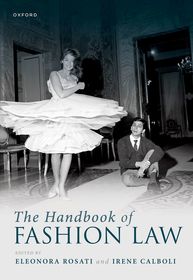
The Handbook of Fashion Law
-
10% KEDVEZMÉNY?
- A kedvezmény csak az 'Értesítés a kedvenc témákról' hírlevelünk címzettjeinek rendeléseire érvényes.
- Kiadói listaár GBP 225.00
-
107 493 Ft (102 375 Ft + 5% áfa)
Az ár azért becsült, mert a rendelés pillanatában nem lehet pontosan tudni, hogy a beérkezéskor milyen lesz a forint árfolyama az adott termék eredeti devizájához képest. Ha a forint romlana, kissé többet, ha javulna, kissé kevesebbet kell majd fizetnie.
- Kedvezmény(ek) 10% (cc. 10 749 Ft off)
- Kedvezményes ár 96 744 Ft (92 138 Ft + 5% áfa)
Iratkozzon fel most és részesüljön kedvezőbb árainkból!
Feliratkozom
107 493 Ft

Beszerezhetőség
Becsült beszerzési idő: Várható beérkezés: 2026. január vége.
A Prosperónál jelenleg nincsen raktáron.
Why don't you give exact delivery time?
A beszerzés időigényét az eddigi tapasztalatokra alapozva adjuk meg. Azért becsült, mert a terméket külföldről hozzuk be, így a kiadó kiszolgálásának pillanatnyi gyorsaságától is függ. A megadottnál gyorsabb és lassabb szállítás is elképzelhető, de mindent megteszünk, hogy Ön a lehető leghamarabb jusson hozzá a termékhez.
A termék adatai:
- Kiadó OUP Oxford
- Megjelenés dátuma 2025. március 14.
- ISBN 9780198938897
- Kötéstípus Keménykötés
- Terjedelem880 oldal
- Méret 252x178x45 mm
- Súly 2052 g
- Nyelv angol 755
Kategóriák
Rövid leírás:
The Handbook of Fashion Law offers readers a comprehensive and multidisciplinary commentary on the legal challenges facing the fashion sector across a range of jurisdictions. Bringing together a diverse range of experts, its contributions consolidate the study, research, and practice of fashion law around the world.
TöbbHosszú leírás:
Over the past few years, 'fashion law' has emerged as a vibrant field of inquiry. The legal and policy issues affecting the fashion sector have been investigated with increasing intensity, while a growing number of private practice lawyers and in-house counsel regard themselves as practising fashion law. But what is fashion law? And what are the specific legal challenges facing the fashion sector, as well as related solutions? The Handbook of Fashion Law seeks to answer these questions by bringing together multiple voices, approaches, and jurisdictions.
Its contributions are organized into four thematic areas. Part I considers the legal infrastructure of the fashion and luxury industries, addressing issues related to intellectual property (IP) as well as the demands of the circular economy, protection of cultural heritage, and freedom of expression and information. Part II maps the IP dimensions of fashion by reviewing the application of design rights, copyright, trade marks, geographical indications, plant variety rights, and trade secrets. Part III analyses specific contractual issues arising in the fashion sector. It examines the application of principles and rules found in regulatory frameworks, including those governing advertising, competition, consumer, and tax laws. Finally, Part IV dissects and evaluates the role of new and emerging technologies in the fashion sector from a legal perspective. It considers concepts such as e-commerce, 3D printing, counterfeiting, artificial intelligence, non-fungible tokens (NFTs), the metaverse, gaming, and wearable technology.
The Handbook of Fashion Law offers readers a multidisciplinary and multijurisdictional understanding of legal challenges facing the fashion sector. Bringing together a diverse range of experts, its contributions offer readers an in-depth, critical, and strategic understanding of the fashion industry's legal intricacies.
The Handbook of Fashion Law is set to become the leading scholarly authority on fashion law, offering valuable guidance to scholars and practitioners in the field alike, while its captivating legal analyses make it a must-read for anyone in the legal field with an interest in cross-disciplinary legal works.
Tartalomjegyzék:
Foreword
Introduction: The rise and consolidation of fashion law as a field of practice, study, and research
Part I- The (Developing) Infrastructure of the Fashion and Luxury Industries: intellectual property and beyond
The Legal Protection of Fashion as Intellectual Property: An international perspective
Cross-border Enforcement of IP Rights in the Fashion Sector
The Role, Responsibility, and Liability of Online Intermediaries under EU IP Law
Intellectual Property, Sustainability, and the Circular Economy: Friends or foes in the fashion industry?
Fashion Waste, Trademark Protection, and the Circular Economy: Towards a new public domain for sustainable reuse
The Rise and Lawfulness of Fast Fashion
Design and Fashion: Procrustean metaphors in intellectual property law
The Cultural Heritage and Cultural Appropriation of Fashion Assets
Fashion Statement: Offensive trademarks and fashion in the U.S.
Part II- Protecting Fashion: Mapping the intellectual property dimension
Using Design Law to Protect Inventive Fashion in the UK and EU
Design Patents in the Fashion Industry: A U.S. perspective
Works of Artistic Craftsmanship in Post-Brexit UK
The 'Artistic Value' Requirement in Italy after Cofemel
The Treatment of Works of Applied Art under Portuguese Law in the Post-Cofemel Era
Prêt-à-protect or Prêt-à-copy? Fashion copyright in the United States
The Protection of Well-known Fashion Trade Marks
Legal Protection of Luxury Fashion Brands under EU Trade Mark Law
Non-traditional Fashion Trademarks: To protect or not to protect? Comparative examples
The Practical Challenges of Obtaining and Maintaining 3D Trade Mark Registrations from an EU Perspective
Geographical Indications in the Fashion Industry: Safeguarding knowledge and culture or fuelling trade unfair competition
Patents in the Fashion Industry
Plant Variety Rights for Sustainable Fashion
Fast Secrets: Trade secrets in fashion
Part III - Contractual, Competition, and Regulatory Issues in the Fashion Industry
Licensing and Merchandising of Fashion Assets
Collaboration of (or with) Well-known Trademarks as a Strategy for Strengthening Market Power in the Luxury Fashion Field
Contracts of Creative Fashion Workers
Competition Law and the Fashion Industry: Limits to brand management
Regulatory and Legal Considerations Relating to Influencer Marketing from a UK Perspective
Misleading and Comparative Advertising in the Fashion Sector
Greenwashing and Sustainability Claims
Consumer Protection in the Fashion Industry from an EU Perspective
Building a Successful Fashion Brand: A corporate and tax law perspective
Part IV - Tech and Fashion: Legal challenges and solutions
Ecommerce and Data Protection Issues in the Fashion Industry
Legal Implications of 3D Printing in Fashion
Counterfeiting: technological and legal tools
'Algorithm Fashion': An EU perspective on copyright-related challenges to anticipating consumers' spending decisions
The Impact of Artificial Intelligence on the Fashion Sector: A moral rights perspective
Fashion Brands in the Metaverse: Legal and policy implications
Fashion Tokens
Fashion, Gaming, and Intellectual Property
Giving Surveillance Capitalism a Makeover: Wearable technology in the fashion industry and the challenges for privacy and data protection law











